








 |
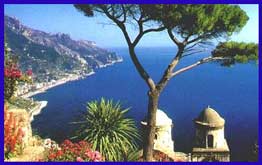 Founded
probably in the 4th century a.C. by Roman populations escaping from barbarians,
Ravello is situated in a splendid position, on a rocky spur astride the Dragon's
and Reginna's Valleys. It is situated in a more elevated position than the
other pearls of the Amalfi Coast and it can boast exceptional landscapes that
have earned Villa Cimbrone's terrace the name of "Terrace of Infinity".
The writer Andre Gide has given us a splendid and synthetic description: "Ravello
is nearer to the sky than it is to the shore". It already enjoyed a good
economic development when it was part of the Amalfi Republic, but Ravello
rebelled against the Republic when the Amalfi people betrayed the Norman king. Founded
probably in the 4th century a.C. by Roman populations escaping from barbarians,
Ravello is situated in a splendid position, on a rocky spur astride the Dragon's
and Reginna's Valleys. It is situated in a more elevated position than the
other pearls of the Amalfi Coast and it can boast exceptional landscapes that
have earned Villa Cimbrone's terrace the name of "Terrace of Infinity".
The writer Andre Gide has given us a splendid and synthetic description: "Ravello
is nearer to the sky than it is to the shore". It already enjoyed a good
economic development when it was part of the Amalfi Republic, but Ravello
rebelled against the Republic when the Amalfi people betrayed the Norman king.
Roberta
il Guiscardo in 1081, electing their own Doge. Ravello refused to follow the
Amalfi people towards betrayal and deserved the appellation of Rebello, from
which today its name still derives, by the Amalfi population. However, in that
occasion, it had the support of Pope Vittore III who firstly redeemed it from
subordination to Amalfi, making it a bishop's palace and subsequently (1086)
making it an Episcopal seat.
It
then became an economic power, seat of flourishing textile industries and as a
result has left indirect testimonies in an elevated number of artistic
treasures of churches and villas . From the pillage carried out in 1137 by
people from Pisa, a slow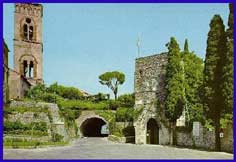 decline began
decline began
and
broke off only in the last century when Ravello became a preferred destination
of the Grand Tour, educational and pleasure travels of European intellectuals
and artists. In Ravello Wagner, Longfellow and many others stayed for a time,
and everybody was enchanted by the extraordinary fascination of these places.
Last but not least in Ravello Greta Garbo hid for one of her elopements that
impassioned readers of society news all over the world in the thirties. Among
the numerous churches in Ravello, undoubtedly the Cathedral and Chiesa del Toro,
besides the famous S. Francesco cloister, deserve a particular mention. Orso
Pavicio, the first bishop of Ravello, ordered the Cathedral to be built.
 The
building began in 1087 and went on for many years with integrative and
additional interventions aimed at increasing decoration splendour. The last
remarkable intervention occurred in 1786; recently a restoration aimed at
recovering the original parts of the sacred building has been begun. The
unadorned front has been restored many times. However some original elements,
such as a million window with two lights, three eyes and four columns of the
ancient pronaos, destroyed by an earthquake, remain. The marble portal and the
bronze door of 1179 are very beautiful. The door is composed of 54 panels, built
by Barisano da Trani, where he portrayed Passion scenes, and scenes of saints
and warriors, one of which grasps a characteristic oriental arch in confirmation
of the Byzantium influence still exerted in Italy in that time. The
building began in 1087 and went on for many years with integrative and
additional interventions aimed at increasing decoration splendour. The last
remarkable intervention occurred in 1786; recently a restoration aimed at
recovering the original parts of the sacred building has been begun. The
unadorned front has been restored many times. However some original elements,
such as a million window with two lights, three eyes and four columns of the
ancient pronaos, destroyed by an earthquake, remain. The marble portal and the
bronze door of 1179 are very beautiful. The door is composed of 54 panels, built
by Barisano da Trani, where he portrayed Passion scenes, and scenes of saints
and warriors, one of which grasps a characteristic oriental arch in confirmation
of the Byzantium influence still exerted in Italy in that time.
The
inside, with nave and two aisles, is magnificently decorated. In the centre,
there is a marble pulpit of 1200, built by Niccolo di Bartolomeo from Foggia who
also made the woman's head, a sculpture of Sigilgaita, the wife of Nicola
Rufolo, the generous patron who commissioned the pulpit to the Apulian artist.
Today
this sculpture is in the Museum annexed to the Cathedral that also deserves a
visit. In front of the pulpit, we can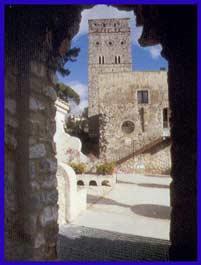 admire an ambo richly decorated by mosaics, commissioned by another bishop of
Ravello, Costantino Rogadeo. The mosaics describe Giona's myth, who was
swallowed and spit out again by Pistrice, a monstrous animal. On the left of the
high altar there is the chapel of S. Pantaleone, to whom the Cathedral is
dedicated. Here the Saint's relics and a reliquary containing his blood are
preserved. According to the
admire an ambo richly decorated by mosaics, commissioned by another bishop of
Ravello, Costantino Rogadeo. The mosaics describe Giona's myth, who was
swallowed and spit out again by Pistrice, a monstrous animal. On the left of the
high altar there is the chapel of S. Pantaleone, to whom the Cathedral is
dedicated. Here the Saint's relics and a reliquary containing his blood are
preserved. According to the
tradition
every year his blood liquefies on July 27th in the anniversary of his martyrdom
, which took place in 305. The Church of S. Giovanni del Toro was built in the
12th century and was subsequently restored several times over. In the inside,
there is a 12th-century pulpit, commissioned by the rich family Bovio from
Ravello and built by Alfano da Termoli. Like the one preserved in the
Cathedral, it is decorated by mosaics portraying Giona and Pistrice. In the
crypt, it is possible to admire some 14th-century frescoes. Furthermore, an
interesting 13th-century cloister is annexed to the Church of S. Francesco.
The builder of Villa Cimbrone was inspired by this cloister and reproduced it
inside its gardens.
Villa
Rufolo
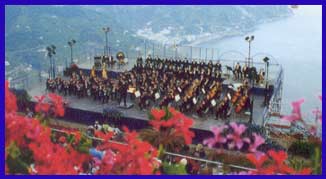 Villa
Rufolo is very ancient, it was built approximately in 1280 by the ho-monymous
family, one of the richest and most important families in Ravello. Even though
it has been rearranged, the building still completely expresses an interesting
Arabian-Norman style. Through a luxuriant garden, which is steeper and wilder
than the well-arranged and elegant gardens of Villa Cimbrone, we arrive at
roof-gardens hanging over the sea. Here, every year Wagner's concerts are
celebrated as a memento of Richard Wagner's stay. Villa
Rufolo is very ancient, it was built approximately in 1280 by the ho-monymous
family, one of the richest and most important families in Ravello. Even though
it has been rearranged, the building still completely expresses an interesting
Arabian-Norman style. Through a luxuriant garden, which is steeper and wilder
than the well-arranged and elegant gardens of Villa Cimbrone, we arrive at
roof-gardens hanging over the sea. Here, every year Wagner's concerts are
celebrated as a memento of Richard Wagner's stay.
Apart
from the musical quality, that is exceptional, the audience is enchanted to see
the orchestra that plays as if it were suspended half-way up on a uniformly blue
setting, represented by sky and sea.
This
is the so-called Klingsor's Tower, traditionally named this way as memento of
Richard Wagner's visit to Ravello. In fact it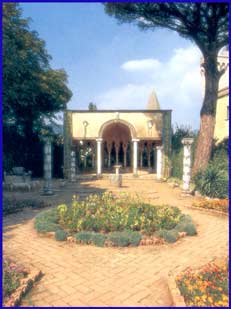 was Villa Rufolo's splendid gardens that inspired the very famous Klingsor's
garden which
was Villa Rufolo's splendid gardens that inspired the very famous Klingsor's
garden which
played
a great role in the German culture and imagination in the twentieth century.
As matter of fact, subsequently Mann, Hess and other writers will refer to it.
The
architectonic pattern of arches is very much present on the Coast and above all
in Ravello. We have both lancet arches with three-lobed columns in the Arabian
tradition, or arches with a short curve, of Byzantine or going further back,
of Roman origin.
However,
there are elements that are present in almost all the monuments of Ravello's
glorious and rich past. On the other hand even in nature, due to wind and sea
erosion, this architectonic element is present: along the entire Coast there
are, in fact, many natural arches both along coasts and inside steep gorges.
Villa
Cimbrone
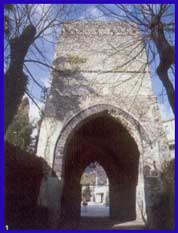 We
cannot but visit the already-quoted Villa Cimbrone. It was built in the
twentieth century and was commissioned by the English nobleman William Bechett.
This villa imitates classicized and medieval styles and forms. Its celebrity is
due to the already-quoted "Terrace of infinity", that is really one
of the most charming places on the Coast. But the beauty of the Villa consists
in its gardens, decorated by statues, busts and marble groups, among them we
have to remember the temple in Doric style with the marble statue of Cerere;
Bacchus's temple, with a bronze sculptural group and a reproduction of David by
Vernocchio. In the cloister, just on the left of the entrance, there is a bas-relief
reproducing the seven deadly sins. We
cannot but visit the already-quoted Villa Cimbrone. It was built in the
twentieth century and was commissioned by the English nobleman William Bechett.
This villa imitates classicized and medieval styles and forms. Its celebrity is
due to the already-quoted "Terrace of infinity", that is really one
of the most charming places on the Coast. But the beauty of the Villa consists
in its gardens, decorated by statues, busts and marble groups, among them we
have to remember the temple in Doric style with the marble statue of Cerere;
Bacchus's temple, with a bronze sculptural group and a reproduction of David by
Vernocchio. In the cloister, just on the left of the entrance, there is a bas-relief
reproducing the seven deadly sins.
Scala
Founded
in the 6" century, its history is strictly linked to that of the Sea
Republic of Amalfi. It is the birthplace of the blessed Gerardo de Saxo, who
founded the order of the Knights Hospitallers, the present Sovereign Military
Order of the Knights of Malta.
|
